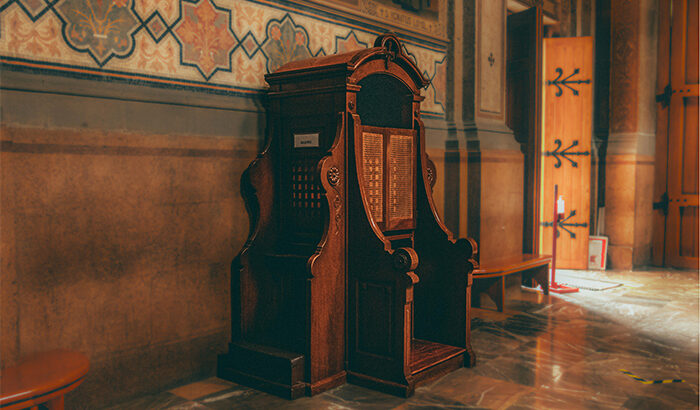Q: Is a parish required to provide a screen and kneeler in the confessional? Our pastor moved our confessional from a room with screen and kneeler to a family room that does not have a screen or kneeler. So, our parishioners no longer have the option to use a screen and kneeler. Our second graders will be receiving their first Confession soon and were taught that they would have the option to confess behind a screen. Our pastor seems reluctant to offer this option. Is he required to offer this option?
A: Technically, yes, parishes are required to have a confessional that includes some sort of screen.
The Code of Canon Law gives us some clear directives regarding the structure of the confessional. Specifically, Canon 964, Paragraph 2 tells us: “The conference of bishops is to establish norms regarding the confessional; it is to take care, however, that there are always confessionals with a fixed grate between the penitent and the confessor in an open place so that the faithful who wish to can use them freely.”
Breaking down this section of Canon 964, the local bishops’ conference, such as the U.S. Conference of Catholic Bishops, or USCCB, can make their own local proper law regarding some aspects of how a confessional is set up within their own territory. As in other cases where a bishops’ conference is empowered to set up their own norms, this is to ensure that local cultural expectations and pastoral needs are appropriately considered.
Still, this canon makes a point to note that in churches there must always be “confessionals with a fixed grate between the penitent and the confessor.” Since this is spelled out in the Church’s universal law, it is not an option for local bishops’ conferences to opt out of this directive.
Very strictly speaking, a ‘fixed grate’ denotes a barrier, but not necessarily a screen. However, since the possibility of anonymous confessions is a very well-established practice, in most cases the canonical ‘fixed grate’ will be a screen or at least some other system of preserving anonymity (such as an opaque curtain behind mental latticework).
Looking at the USCCB’s local laws, or ‘complementary norms’ on the confessional, we read: “Provision must be made in each church or oratory for a sufficient number of places for sacramental confessions which are clearly visible, truly accessible, and which provide a fixed grille between the penitent and the confessor. Provision should also be made for penitents who wish to confess face-to-face.”
Therefore, in the United States at least, face-to-face confessions without a screen are a legitimate option. But these local norms on the confessional echo the universal law in that they still require and presume that confessionals in churches will have a screen.
On a related note, Canon 964, Paragraph 3 goes on to state that “confessions are not to be heard outside a confessional without a just cause.” In canon law, a ‘just cause’ is a relatively low bar to meet. Essentially, a canonical ‘just cause’ is basically the same as a ‘good reason’.
While the Church expects confessions to be heard in a designated confessional under ordinary circumstances, there are times when it would be permissible to celebrate the sacrament someplace else. For example, a priest would be more than justified in hearing a hospitalised patient’s confession at their bedside.
In your own situation, it might be worth having a respectful conversation with your pastor. It may be that he would hear confessions in traditional confessional if this was requested. And if it makes you feel more comfortable, you are always free to confess at a parish other than your own.
Jenna Marie Cooper, who holds a licentiate in canon law, is a consecrated virgin and a canonist whose column appears weekly at OSV News. Send your questions to CatholicQA@osv.com.



